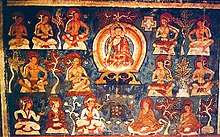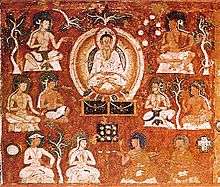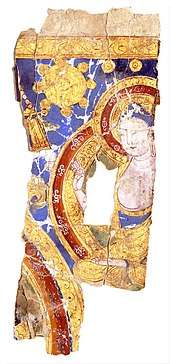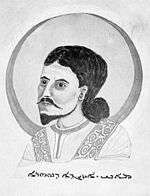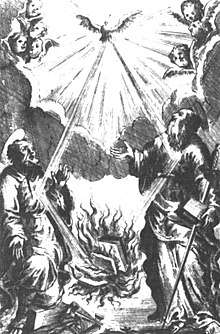Manichaeism
Manichæism (/ˌmænɪˈkiːɪzəm/;[1] in New Persian آیین مانی Ãyīnⁱ Mānī; Chinese: 摩尼教; pinyin: Móní Jiào) was a major religion[2] founded in the 3rd century AD by the Persian[3] prophet Mani (c. 216–274 AD) in the Sasanian Empire.[4][5]
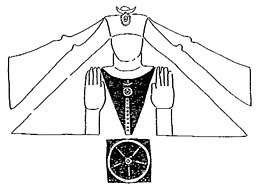
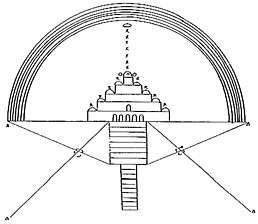
 |
|
|
|
|
|
Influenced by |
Manichaeism taught an elaborate dualistic cosmology describing the struggle between a good, spiritual world of light, and an evil, material world of darkness.[6] Through an ongoing process that takes place in human history, light is gradually removed from the world of matter and returned to the world of light, whence it came. Its beliefs were based on local Mesopotamian religious movements and Gnosticism.[7] It revered Mani as the final prophet after Zoroaster, Gautama Buddha, and Jesus.
Manichaeism was quickly successful and spread far through the Aramaic-speaking regions.[8] It thrived between the third and seventh centuries, and at its height was one of the most widespread religions in the world. Manichaean churches and scriptures existed as far east as China and as far west as the Roman Empire.[9] It was briefly the main rival to Christianity before the spread of Islam in the competition to replace classical paganism. Manichaeism survived longer in the east than in the west, and it appears to have finally faded away after the 14th century in south China,[10] contemporary to the decline of the Church of the East in Ming China. While most of Manichaeism's original writings have been lost, numerous translations and fragmentary texts have survived.
An adherent of Manichaeism was called a Manichaean or Manichean, or Manichee, especially in older sources.[11][12]
History
Life of Mani
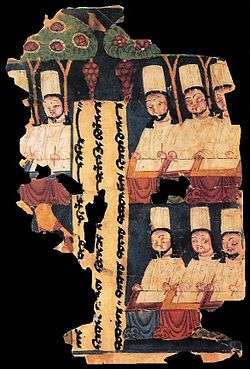
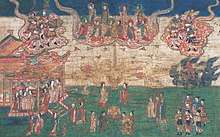
Mani was an Iranian[13][14][15] born in 216 in or near Seleucia-Ctesiphon (now al-Mada'in) in the Parthian Empire.[16] According to the Cologne Mani-Codex,[17] Mani's parents were members of the Jewish Christian Gnostic sect known as the Elcesaites.[18]
Mani composed seven works, six of which were written in the Syriac language, a late variety of Aramaic. The seventh, the Shabuhragan,[19] was written by Mani in Middle Persian and presented by him to the Sasanian emperor, Shapur I. Although there is no proof Shapur I was a Manichaean, he tolerated the spread of Manichaeism and refrained from persecuting it within his empire's boundaries.[20]
According to one tradition, it was Mani himself who invented the unique version of the Syriac script known as the Manichaean alphabet, which was used in all of the Manichaean works written within the Sasanian Empire, whether they were in Syriac or Middle Persian, and also for most of the works written within the Uyghur Khaganate. The primary language of Babylon (and the administrative and cultural language of the Sassanid Empire) at that time was Eastern Middle Aramaic, which included three main dialects: Jewish Babylonian Aramaic (the language of the Babylonian Talmud), Mandaean (the language of Mandaeism), and Syriac, which was the language of Mani, as well as of the Syriac Christians.
While Manichaeism was spreading, existing religions such as Zoroastrianism were still popular and Christianity was gaining social and political influence. Although having fewer adherents, Manichaeism won the support of many high-ranking political figures. With the assistance of the Sasanian Empire, Mani began missionary expeditions. After failing to win the favour of the next generation of Persian royalty, and incurring the disapproval of the Zoroastrian clergy, Mani is reported to have died in prison awaiting execution by the Persian Emperor Bahram I. The date of his death is estimated at 276–277.[16]
Influences
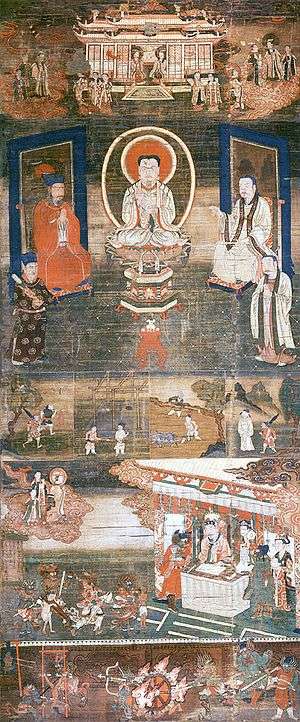
Mani believed that the teachings of Gautama Buddha, Zoroaster, and Jesus were incomplete, and that his revelations were for the entire world, calling his teachings the "Religion of Light".[16] Manichaean writings indicate that Mani received revelations when he was 12 and again when he was 24, and over this time period he grew dissatisfied with the Elcesaite sect he was born into.[21] Mani began preaching at an early age and was possibly influenced by contemporary Babylonian-Aramaic movements such as Mandaeism, and Aramaic translations of Jewish apocalyptic writings similar to those found at Qumran (such as the book of Enoch literature), and by the Syriac dualist-gnostic writer Bardaisan (who lived a generation before Mani). With the discovery of the Mani-Codex, it also became clear that he was raised in a Jewish-Christian baptism sect, the Elcesaites, and was influenced by their writings, as well. According to biographies preserved by Ibn al-Nadim and the Persian polymath al-Biruni, he received a revelation as a youth from a spirit, whom he would later call his Twin (Aramaic: תאומא tɑʔwmɑ, from which is also derived the name of the Thomas the Apostle, the "twin"), his Syzygos (Koinē Greek: σύζυγος "spouse, partner", in the Cologne Mani-Codex), his Double, his Protective Angel or Divine Self. It taught him truths that he developed into a religion. His divine Twin or true Self brought Mani to self-realization. He claimed to be the Paraclete of the Truth, as promised by Jesus in the New Testament.[22]
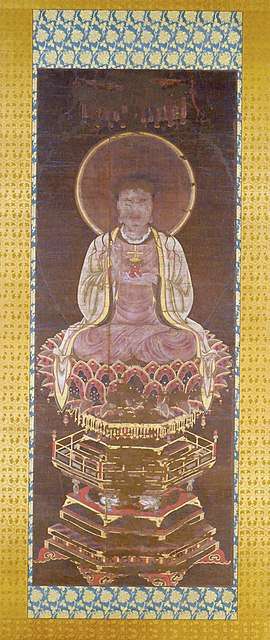
Manichaeism's views on Jesus are described by historians:
Jesus in Manichaeism possessed three separate identities: (1) Jesus the Luminous, (2) Jesus the Messiah and (3) Jesus patibilis (the suffering Jesus). (1) As Jesus the Luminous ... his primary role was as supreme revealer and guide and it was he who woke Adam from his slumber and revealed to him the divine origins of his soul and its painful captivity by the body and mixture with matter. Jesus the Messiah was a historical being who was the prophet of the Jews and the forerunner of Mani. However, the Manichaeans believed he was wholly divine. He never experienced human birth as notions of physical conception and birth filled the Manichaeans with horror and the Christian doctrine of virgin birth was regarded as equally obscene. Since he was the light of the world, where was this light, they asked, when he was in the womb of the Virgin? (2) Jesus the Messiah was truly born at his baptism as it was on that occasion that the Father openly acknowledged his sonship. The suffering, death and resurrection of this Jesus were in appearance only as they had no salvific value but were an exemplum of the suffering and eventual deliverance of the human soul and a prefiguration of Mani's own martyrdom. (3) The pain suffered by the imprisoned Light-Particles in the whole of the visible universe, on the other hand, was real and immanent. This was symbolized by the mystic placing of the Cross whereby the wounds of the passion of our souls are set forth. On this mystical Cross of Light was suspended the Suffering Jesus (Jesus patibilis) who was the life and salvation of Man. This mystica cruxificio was present in every tree, herb, fruit, vegetable and even stones and the soil. This constant and universal suffering of the captive soul is exquisitely expressed in one of the Coptic Manichaean psalms.[23]
Augustine also noted that Mani declared himself to be an "apostle of Jesus Christ".[24] Manichaean tradition is also noted to have claimed that Mani was the reincarnation of different religious figures such as Buddha, Krishna, Zoroaster, and Jesus.[25]
Academics also note that since much of what is known about Manichaeism comes from later 10th- and 11th-century Muslim historians like Al-Biruni and especially ibn al-Nadim (and his Fihrist), "Islamic authors ascribed to Mani the claim to be the Seal of the Prophets."[26] In reality, for Mani the expression "seal of prophecy" refers to his disciples, who testify for the veracity of his message, as a seal does.[27][28]
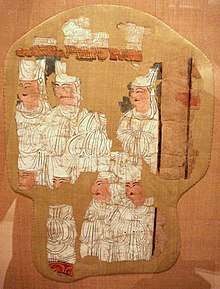
Another source of Mani's scriptures was original Aramaic writings relating to the Book of Enoch literature (see the Book of Enoch and the Second Book of Enoch), as well as an otherwise unknown section of the Book of Enoch called The Book of Giants. This book was quoted directly, and expanded on by Mani, becoming one of the original six Syriac writings of the Manichaean Church. Besides brief references by non-Manichaean authors through the centuries, no original sources of The Book of Giants (which is actually part six of the Book of Enoch) were available until the 20th century.[29]
Scattered fragments of both the original Aramaic "Book of Giants" (which were analyzed and published by Józef Milik in 1976)[30] and of the Manichaean version of the same name (analyzed and published by Walter Bruno Henning in 1943)[31] were found with the discovery in the twentieth century of the Dead Sea Scrolls in the Judaean Desert and the Manichaean writings of the Uyghur Manichaean kingdom in Turpan. Henning wrote in his analysis of them:
It is noteworthy that Mani, who was brought up and spent most of his life in a province of the Persian empire, and whose mother belonged to a famous Parthian family, did not make any use of the Iranian mythological tradition. There can no longer be any doubt that the Iranian names of Sām, Narīmān, etc., that appear in the Persian and Sogdian versions of the Book of the Giants, did not figure in the original edition, written by Mani in the Syriac language.[31]
By comparing the cosmology in the Book of Enoch literature and the Book of Giants, alongside the description of the Manichaean myth, scholars have observed that the Manichaean cosmology can be described as being based, in part, on the description of the cosmology developed in detail in the Book of Enoch literature.[32] This literature describes the being that the prophets saw in their ascent to heaven, as a king who sits on a throne at the highest of the heavens. In the Manichaean description, this being, the "Great King of Honor", becomes a deity who guards the entrance to the world of light, placed at the seventh of ten heavens.[33] In the Aramaic Book of Enoch, in the Qumran writings in general, and in the original Syriac section of Manichaean scriptures quoted by Theodore bar Konai,[34] he is called "malka raba de-ikara" (the Great King of Honor).
Mani was also influenced by writings of the Assyrian gnostic Bardaisan (154–222), who, like Mani, wrote in Syriac, and presented a dualistic interpretation of the world in terms of light and darkness, in combination with elements from Christianity.
Noting Mani's travels to the Kushan Empire (several religious paintings in Bamyan are attributed to him) at the beginning of his proselytizing career, Richard Foltz postulates Buddhist influences in Manichaeism:
Buddhist influences were significant in the formation of Mani's religious thought. The transmigration of souls became a Manichaean belief, and the quadripartite structure of the Manichaean community, divided between male and female monks (the "elect") and lay followers (the "hearers") who supported them, appears to be based on that of the Buddhist sangha.[35]
The Kushan monk Lokakṣema began translating Pure Land Buddhist texts into Chinese in the century prior to Mani arriving there, and the Chinese texts of Manichaeism are full of uniquely Buddhist terms taken directly from these Chinese Pure Land scriptures, including the term "pure land" (淨土 Jìngtǔ) itself.[36] However, the central object of veneration in Pure Land Buddhism, Amitābha, the Buddha of Infinite Light, does not appear in Chinese Manichaeism, and seems to have been replaced by another deity.
Spread

Manichaeism spread with extraordinary speed through both the East and West. It reached Rome through the apostle Psattiq by 280, who was also in Egypt in 244 and 251. It was flourishing in the Faiyum in 290.
Manichaean monasteries existed in Rome in 312 during the time of Pope Miltiades.
In 291, persecution arose in the Sasanian Empire with the murder of the apostle Sisin by Emperor Bahram II, and the slaughter of many Manichaeans. In 296, Roman Emperor Diocletian decreed against the Manichaeans: "We order that their organizers and leaders be subject to the final penalties and condemned to the fire with their abominable scriptures." This resulted in martyrdom for many in Egypt and North Africa (see Diocletian Persecution). By 354, Hilary of Poitiers wrote that Manichaeism was a significant force in Roman Gaul. In 381, Christians requested Theodosius I to strip Manichaeans of their civil rights. Starting in 382, the emperor issued a series of edicts to suppress Manichaeism and punish its followers.[37]
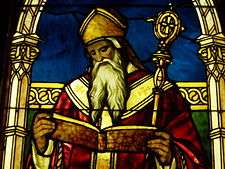
Augustine of Hippo (354–430) converted to Christianity from Manichaeism in the year 387. This was shortly after the Roman emperor Theodosius I had issued a decree of death for all Manichaean monks in 382 and shortly before he declared Christianity to be the only legitimate religion for the Roman Empire in 391. Due to the heavy persecution, the religion almost disappeared from western Europe in the fifth century and from the eastern portion of the empire in the sixth century.[38] According to his Confessions, after nine or ten years of adhering to the Manichaean faith as a member of the group of "hearers", Augustine became a Christian and a potent adversary of Manichaeism (which he expressed in writing against his Manichaean opponent Faustus of Mileve), seeing their beliefs that knowledge was the key to salvation as too passive and not able to effect any change in one's life.[39]
I still thought that it is not we who sin but some other nature that sins within us. It flattered my pride to think that I incurred no guilt and, when I did wrong, not to confess it ... I preferred to excuse myself and blame this unknown thing which was in me but was not part of me. The truth, of course, was that it was all my own self, and my own impiety had divided me against myself. My sin was all the more incurable because I did not think myself a sinner.[40]
Some modern scholars have suggested that Manichaean ways of thinking influenced the development of some of Augustine's ideas, such as the nature of good and evil, the idea of hell, the separation of groups into elect, hearers, and sinners, and the hostility to the flesh and sexual activity, and his dualistic theology.[41] These influences of Manichaeism in Augustine's Christian thinking may well have been part of the conflict between Augustine and Pelagius, a British monk whose theology, being less influenced by the Latin Church, was non-dualistic, and one that saw the created order, and mankind in particular, as having a Divine core, rather than a 'darkness' at its core.
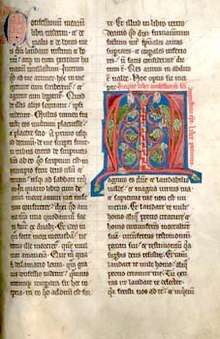
How Manichaeism might have influenced Christianity continues to be debated. Manichaeism could have influenced the Bogomils, Paulicians, and Cathars. However, these groups left few records, and the link between them and Manichaeans is tenuous. Regardless of its accuracy, the charge of Manichaeism was leveled at them by contemporary orthodox opponents, who often tried to make contemporary heresies conform to those combatted by the church fathers. Whether the dualism of the Paulicians, Bogomils, and Cathars and their belief that the world was created by a Satanic demiurge were due to influence from Manichaeism is impossible to determine. The Cathars apparently adopted the Manichaean principles of church organization. Priscillian and his followers may also have been influenced by Manichaeism. The Manichaeans preserved many apocryphal Christian works, such as the Acts of Thomas, that would otherwise have been lost.[42]
Manichaeism maintained a sporadic and intermittent existence in the west (Mesopotamia, Africa, Spain, France, North Italy, the Balkans) for a thousand years, and flourished for a time in Persia and even further east in Northern India, Western China, and Tibet. While it had long been thought that Manichaeism arrived in China only at the end of the seventh century, a recent archaeological discovery demonstrated that it was already known there in the second half of the 6th century.[43]
Some Sogdians in Central Asia believed in the religion.[44][45] Uyghur khagan Boku Tekin (759–780) converted to the religion in 763 after a three-day discussion with its preachers,[46][47] the Babylonian headquarters sent high rank clerics to Uyghur, and Manichaeism remained the state religion for about a century before the collapse of the Uyghur Khaganate in 840. In the east it spread along trade routes as far as Chang'an, the capital of Tang China.[48][49] After the Tang Dynasty, some Manichaean groups participated in peasant movements. The religion was used by many rebel leaders to mobilise followers. In the Song and Yuan dynasties of China remnants of Manichaeism continued to leave a legacy contributing to sects such as the Red Turbans. During the Song Dynasty, the Manichaeans were derogatorily referred by the Chinese as chicai simo (meaning that they "abstain from meat and worship demons"). An account in Fozu Tongji, an important historiography of Buddhism in China compiled by Buddhist scholars during 1258–1269, says that the Manichaeans worshipped the "white Buddha" and their leader wore a violet headgear, while the followers wore white costumes. Many Manichaeans took part in rebellions against the Song government and were eventually quelled. After that, all governments were suppressive against Manichaeism and its followers and the religion was banned by the Ming Dynasty in 1370.[50][51][52]
Manichaeism spread to Tibet during the Tibetan Empire. There was likely a serious attempt to introduce the religion to the Tibetans as the text Criteria of the Authentic Scriptures (a text attributed to Tibetan Emperor Trisong Detsen) makes a great effort to attack Manichaeism by stating that Mani was a heretic who took ideas from all faiths and blended them together into a deviating and inauthentic form.[53]
Manichaeans in Iran tried to assimilate their religion along with Islam in the Muslim caliphates.[54] Relatively little is known about the religion during the first century of Islamic rule. During the early caliphates, Manichaeism attracted many followers. It had a significant appeal among the Muslim society, especially among the elites. Due to the appeal of its teachings, many Muslims adopted the ideas of its theology and some even became dualists. An apologia for Manichaeism ascribed to ibn al-Muqaffa' defended its phantasmagorical cosmogony and attacked the fideism of Islam and other monotheistic religions. The Manichaeans had sufficient structure to have a head of their community.[55][56][57]
Under the eighth-century Abbasid Caliphate, Arabic zindīq and the adjectival term zandaqa could denote many different things, though it seems primarily (or at least initially) to have signified a follower of Manichaeism however its true meaning is not known.[58] In the ninth century, it is reported that Caliph al-Ma'mun tolerated a community of Manichaeans.[59]
During the early Abbasid period, the Manichaeans underwent persecution. The third Abbasid caliph, al-Mahdi, persecuted the Manichaeans, establishing an inquisition against dualists who if being found guilty of heresy refused to renounce their beliefs, were executed. Their persecution was finally ended in 780s by Harun al-Rashid.[60][61] During the reign of the Caliph al-Muqtadir, many Manichaeans fled from Mesopotamia to Khorasan from fear of persecution and the base of the religion was later shifted to Samarkand.[38][62]
.jpg)
Manichaeism claimed to present the complete version of teachings that were corrupted and misinterpreted by the followers of its predecessors Adam, Zoroaster, Buddha and Jesus. Accordingly, as it spread, it adapted new deities from other religions into forms it could use for its scriptures. Its original Aramaic texts already contained stories of Jesus. When they moved eastward and were translated into Iranian languages, the names of the Manichaean deities (or angels) were often transformed into the names of Zoroastrian yazatas. Thus Abbā dəRabbūṯā ("The Father of Greatness", the highest Manichaean deity of Light), in Middle Persian texts might either be translated literally as pīd ī wuzurgīh, or substituted with the name of the deity Zurwān. Similarly, the Manichaean primal figure Nāšā Qaḏmāyā "The Original Man" was rendered Ohrmazd Bay, after the Zoroastrian god Ohrmazd. This process continued in Manichaeism's meeting with Chinese Buddhism, where, for example, the original Aramaic קריא qaryā (the "call" from the World of Light to those seeking rescue from the World of Darkness), becomes identified in the Chinese scriptures with Guanyin (觀音 or Avalokiteśvara in Sanskrit, literally, "watching/perceiving sounds [of the world]", the bodhisattva of Compassion).
Persecution and extinction
Manichaeism was repressed by the Sasanian Empire.[54] In 291, persecution arose in the Persian empire with the murder of the apostle Sisin by Bahram II, and the slaughter of many Manichaeans. In 296, the Roman emperor Diocletian decreed all the Manichaean leaders to be burnt alive along with the Manichaean scriptures and many Manichaeans in Europe and North Africa were killed. This policy of persecution was also followed by his successors. Theodosius I issued a decree of death for all Manichaean monks in 382 AD.[63] The religion was vigorously attacked and persecuted by both the Christian Church and the Roman state, and the religion almost disappeared from western Europe in the fifth century and from the eastern portion of the empire in the sixth century.[38]
In 732, Emperor Xuanzong of Tang banned any Chinese from converting to the religion, saying it was a heretic religion that was confusing people by claiming to be Buddhism. However, the foreigners who followed the religion were allowed to practice it without punishment.[64] After the fall of the Uyghur Khaganate in 840, which was the chief patron of Manichaeism (which was also the state religion of the Khaganate) in China, all Manichaean temples in China except in the two capitals and Taiyuan were closed down and never reopened since these temples were viewed as a symbol of foreign arrogance by the Chinese (see Cao'an). Even those that were allowed to remain open did not for long. The Manichaean temples were attacked by Chinese people who burned the images and idols of these temples. Manichaean priests were ordered to wear hanfu instead of their traditional clothing, which was viewed as un-Chinese. In 843, Emperor Wuzong of Tang gave the order to kill all Manichaean clerics as part of his Great Anti-Buddhist Persecution, and over half died. They were made to look like Buddhists by the authorities, their heads were shaved, they were made to dress like Buddhist monks and then killed.[49] Although the religion was mostly forbidden and its followers persecuted thereafter in China, it survived till the 14th century in the country. Under the Song dynasty, its followers were derogatorily referred to with the chengyu 吃菜祀魔 (pinyin: chī cài sì mó) "vegetarian demon-worshippers".
Many Manichaeans took part in rebellions against the Song dynasty. They were quelled by Song China and were suppressed and persecuted by all successive governments before the Mongol Yuan dynasty. In 1370, the religion was banned through an edict of the Ming dynasty, whose Hongwu Emperor had a personal dislike for the religion.[49][52][65] Its core teaching influences many religious sects in China, including the White Lotus movement.[66]
According to Wendy Doniger, Manichaeism may have continued to exist in the modern-East Turkestan region until the Mongol conquest in the 13th century.[67]
Manicheans also suffered persecution for some time under the Abbasid Caliphate of Baghdad. In 780, the third Abbasid Caliph, al-Mahdi, started a campaign of inquisition against those who were "dualist heretics" or "Manichaeans" called the zindīq. He appointed a "master of the heretics" (Arabic: الزنادقة صاحب ṣāhib al-zanādiqa), an official whose task was to pursue and investigate suspected dualists, who were then examined by the Caliph. Those found guilty who refused to abjure their beliefs were executed. This persecution continued under his successor, Caliph al-Hadi, and continued for some time during reign of Harun al-Rashid, who finally abolished it and ended it.[60] During the reign of the 18th Abbassid Caliph al-Muqtadir, many Manichaeans fled from Mesopotamia to Khorasan from fear of persecution by him and about 500 of them assembled in Samarkand. The base of the religion was later shifted to this city, which became their new Patriarchate.[38][62]
Manichaean pamphlets were still in circulation in Greek in 9th century Byzantine Constantinople, as the patriarch Photios summarizes and discusses one that he has read by Agapius in his Bibliotheca.
Later movements associated with Manichaeism
During the Middle Ages, several movements emerged that were collectively described as "Manichaean" by the Catholic Church, and persecuted as Christian heresies through the establishment, in 1184, of the Inquisition.[68] They included the Cathar churches of Western Europe. Other groups sometimes referred to as "neo-Manichaean" were the Paulician movement, which arose in Armenia,[69] and the Bogomils in Bulgaria.[42] An example of this usage can be found in the published edition of the Latin Cathar text, the Liber de duobus principiis (Book of the Two Principles), which was described as "Neo-Manichaean" by its publishers.[70] As there is no presence of Manichaean mythology or church terminology in the writings of these groups, there has been some dispute among historians as to whether these groups were descendants of Manichaeism.[71]
Teachings and beliefs
General
Mani's teaching dealt with the origin of evil,[16] by addressing a theoretical part of the problem of evil by denying the omnipotence of God and postulating two opposite powers. Manichaean theology taught a dualistic view of good and evil. A key belief in Manichaeism is that the powerful, though not omnipotent good power (God), was opposed by the eternal evil power (devil). Humanity, the world and the soul are seen as the by-product of the battle between God's proxy, Primal Man, and the devil. The human person is seen as a battle-ground for these powers: the soul defines the person, but it is under the influence of both light and dark. This contention plays out over the world as well as the human body—neither the Earth nor the flesh were seen as intrinsically evil, but rather possessed portions of both light and dark. Natural phenomena (such as rain) were seen as the physical manifestation of this spiritual contention. Therefore, the Manichaean view explained the existence of evil by positing a flawed creation in the formation of which God took no part and which constituted rather the product of a battle by the devil against God.[78]
Cosmogony
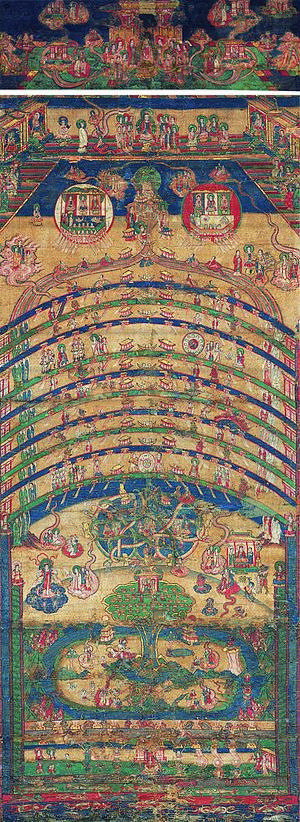
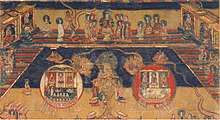
Manichaeism presented an elaborate description of the conflict between the spiritual world of light and the material world of darkness. The beings of both the world of darkness and the world of light have names. There are numerous sources for the details of the Manichaean belief. There are two portions of Manichaean scriptures that are probably the closest thing to the original Manichaean writings in their original languages that will ever be available. These are the Syriac-Aramaic quotation by the Nestorian Christian Theodore bar Konai, in his Syriac "Book of Scholia" (Ketba de-Skolionz, 8th century),[34] and the Middle Persian sections of Mani's Shabuhragan discovered at Turpan (a summary of Mani's teachings prepared for Shapur I[19]).
From these and other sources, it is possible to derive an almost complete description of the detailed Manichaean vision[79] (a complete list of Manichaean deities is outlined below). According to Mani, the unfolding of the universe takes place with three "creations":
The First Creation: Originally, good and evil existed in two completely separate realms, one the World of Light, ruled by the Father of Greatness together with his five Shekhinas (divine attributes of light), and the other the World of Darkness, ruled by the King of Darkness. At a certain point, the Kingdom of Darkness notices the World of Light, becomes greedy for it and attacks it. The Father of Greatness, in the first of three "creations" (or "calls"), calls to the Mother of Life, who sends her son Original Man (Nāšā Qaḏmāyā in Aramaic), to battle with the attacking powers of Darkness, which include the Demon of Greed. The Original Man is armed with five different shields of light (reflections of the five Shekhinas), which he loses to the forces of darkness in the ensuing battle, described as a kind of "bait" to trick the forces of darkness, as the forces of darkness greedily consume as much light as they can. When the Original Man comes to, he is trapped among the forces of darkness.
The Second Creation: Then the Father of Greatness begins the Second Creation, calling to the Living Spirit, who calls to his five sons, and sends a call to the Original Man (Call then becomes a Manichaean deity). An answer (Answer becomes another Manichaean deity) then returns from the Original Man to the World of Light. The Mother of Life, the Living Spirit, and his five sons begin to create the universe from the bodies of the evil beings of the World of Darkness, together with the light that they have swallowed. Ten heavens and eight earths are created, all consisting of various mixtures of the evil material beings from the World of Darkness and the swallowed light. The sun, moon, and stars are all created from light recovered from the World of Darkness. The waxing and waning of the moon is described as the moon filling with light, which passes to the sun, then through the Milky Way, and eventually back to the World of Light.
The Third Creation: Great demons (called archons in bar-Khonai's account) are hung out over the heavens, and then the Father of Greatness begins the Third Creation. Light is recovered from out of the material bodies of the male and female evil beings and demons, by causing them to become sexually aroused in greed, towards beautiful images of the beings of light, such as the Third Messenger and the Virgins of Light. However, as soon as the light is expelled from their bodies and falls to the earth (some in the form of abortions – the source of fallen angels in the Manichaean myth), the evil beings continue to swallow up as much of it as they can to keep the light inside of them. This results eventually in the evil beings swallowing huge quantities of light, copulating, and producing Adam and Eve. The Father of Greatness then sends the Radiant Jesus to awaken Adam, and to enlighten him to the true source of the light that is trapped in his material body. Adam and Eve, however, eventually copulate, and produce more human beings, trapping the light in bodies of mankind throughout human history. The appearance of the Prophet Mani was another attempt by the World of Light to reveal to mankind the true source of the spiritual light imprisoned within their material bodies.
Outline of the beings and events in the Manichaean mythology
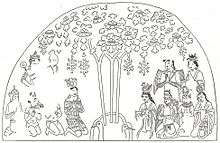
Beginning with the time of its creation by Mani, the Manichaean religion had a detailed description of deities and events that took place within the Manichaean scheme of the universe. In every language and region that Manichaeism spread to, these same deities reappear, whether it is in the original Syriac quoted by Theodore bar Konai,[34] or the Latin terminology given by Saint Augustine from Mani's Epistola Fundamenti, or the Persian and Chinese translations found as Manichaeism spread eastward. While the original Syriac retained the original description that Mani created, the transformation of the deities through other languages and cultures produced incarnations of the deities not implied in the original Syriac writings.
The World of Light
- The Father of Greatness (Syriac: ܐܒܐ ܕܪܒܘܬܐ Abbā dəRabbūṯā; Middle Persian: pīd ī wuzurgīh, or the Zoroastrian deity Zurwān; Parthian: Pidar wuzurgift, Pidar roshn)
- His Five Shekhinas (Syriac: ܚܡܫ ܫܟܝܢܬܗ khamesh shkhinatei; Chinese: 五种大 wǔ zhǒng dà, "five great ones"):[80]
| Shekhina: | Reason | Mind | Intelligence | Thought | Understanding |
|---|---|---|---|---|---|
| Syriac | ܗܘܢܐ hawnā | ܡܕܥܐ maddeʻā | ܪܥܝܢܐ reyānā | ܡܚܫܒܬܐ maḥšavṯɑ | ܬܪܥܝܬܐ tarʻiṯā |
| Parthian | bām | manohmēd | uš | andēšišn | parmānag |
| Chinese | 相 xiāng, "phase" | 心 xīn, "heart" | 念 niàn, "idea" | 思 sī, "thought" | 意 yì, "meaning" |
| Turkic | qut | ög | köngül | saqinç | tuimaq |
| Greek | νοῦς (Nous) | εννοια (Ennoia) | φρονησις (Phronēsis) | ενθυμησις (Enthymēsis) | λογισμος (Logismos) |
| Latin | mens | sensus | prudentia | intellectus | cogitatio |
- The Great Spirit (Middle Persian: Waxsh zindag, Waxsh yozdahr; Latin: Spiritus Potens)
The first creation
- The Mother of Life (Syriac: ܐܡܐ ܕܚܝܐ imā dəḥayyē)
- The First Man (Syriac: ܐܢܫܐ ܩܕܡܝܐ Nāšā Qaḏmāyā; Middle Persian: Ohrmazd Bay, the Zoroastrian god of light and goodness; Latin: Primus Homo)
- His five Sons (the Five Light Elements; Middle Persian: Amahrāspandān; Parthian: panj rōšn)
- Ether (Middle Persian: frâwahr, Parthian: ardāw)
- Wind (Middle Persian and Parthian: wād)
- Light (Middle Persian and Parthian: rōšn)
- Water (Middle Persian and Parthian: āb)
- Fire (Middle Persian and Parthian: ādur)
- His sixth Son, the Answer-God (Syriac: ܥܢܝܐ ʻanyā; Middle Persian: xroshtag; Chinese: 勢至 Shì Zhì "The Power of Wisdom", a Chinese bodhisattva). The answer sent by the First Man to the Call from the World of Light.
- The Living Self (made up of the five Elements; Middle Persian: Griw zindag, Griw rōšn)
The second creation
- The Friend of the Lights (Syriac: ܚܒܝܒ ܢܗܝܖܐ ḥaviv nehirē). Calls to:
- The Great Builder (Syriac: ܒܢ ܖܒܐ ban rabbā). In charge of creating the new world that will separate the darkness from the light. He calls to:
- The Living Spirit (Syriac: ܪܘܚܐ ܚܝܐ ruḥā ḥayyā; Middle Persian: Mihryazd; Chinese: 淨活風 Jìnghuófēng; Latin: Spiritus Vivens). Acts as a demiurge, creating the structure of the material world.
- His five Sons (Syriac: ܚܡܫܐ ܒܢܘܗܝ ḥamšā benawhy)
- The Keeper of the Splendour (Syriac: ܨܦܬ ܙܝܘܐ ṣfat ziwā; Latin: Splenditenens; Chinese: 催明). Holds up the ten heavens from above.
- The King of Glory (Syriac: ܡܠܟ ܫܘܒܚܐ mlex šuvḥā; Latin: Rex Gloriosus; Chinese: 地藏 Dìzàng "Earth Treasury", a Chinese bodhisattva).
- The Adamas of Light (Syriac: ܐܕܡܘܣ ܢܘܗܪܐ adamus nuhrā; Latin: Adamas; Chinese: 降魔使 Jiàngmó shǐ). Fights with and overcomes an evil being in the image of the King of Darkness.
- The Great King of Honour (Syriac: ܡܠܟܐ ܪܒܐ ܕܐܝܩܪܐ malkā rabbā dikkārā; Dead Sea Scrolls Aramaic: מלכא רבא דאיקרא malka raba de-ikara; Latin: Rex Honoris; Chinese: 十天王 Shítiān Wáng "Ten-heaven King"). A being that plays a central role in The Book of Enoch (originally written in Aramaic), as well as Mani's Syriac version of it, the Book of Giants. Sits in the seventh heaven of the ten heavens (compare Buddhist division of the ten realms) and guards the entrance to the world of light.
- Atlas (Syriac: ܣܒܠܐ sebblā; Latin: Atlas; Chinese: 持世主 Chíshìzhǔ). Supports the eight worlds from below.
- His sixth Son, the Call-God (Syriac: ܩܪܝܐ qaryā; Middle Persian: Padvaxtag; Chinese: 觀音 Guanyin "watching/perceiving sounds [of the world]", the Chinese Bodhisattva of Compassion). Sent from the Living Spirit to awaken the First Man from his battle with the forces of darkness.
The third creation
.jpg)
- The Third Messenger (Syriac: ܐܝܙܓܕܐ izgaddā; Middle Persian narēsahyazad, Parthian: hridīg frēštag; Latin: tertius legatus)
- Jesus the Splendour (Syriac: ܝܫܘܥ ܙܝܘܐ Ishoʻ Ziwā). Sent to awaken Adam and Eve to the source of the spiritual light trapped within their physical bodies.
- The Maiden of Light
- The Twelve Virgins of Light (Syriac: ܬܪܬܥܣܪܐ ܒܬܘܠܬܐ tratʻesrā btultē; Middle Persian kanīgān rōšnān; Chinese: 日宮十二化女 Rìgōng shí'èr huànǚ).[81] Reflected in the twelve constellations of the Zodiac.
- The Column of Glory (Syriac: ܐܣܛܘܢ ܫܘܒܚܐ esṭun šuvḥā; Middle Persian: srōš-ahrāy, from Sraosha; Chinese: 蘇露沙羅夷, Sūlù shāluóyí and 盧舍那, Lúshěnà, both phonetic from Middle Persian srōš-ahrāy). The path that souls take back to the World of Light; corresponds to the Milky Way.
- The Great Nous
- His five Limbs
- Reason
- Mind
- Intelligence
- Thought
- Understanding
- The Just Justice
- The Last God
The World of Darkness
- The Prince of Darkness (Syriac: ܡܠܟ ܚܫܘܟܐ mlex ḥešoxā; Middle Persian: Ahriman, the Zoroastrian supreme evil being)
- His five evil kingdoms Evil counterparts of the five elements of light, the lowest being the kingdom of Darkness.
- His son (Syriac: ܐܫܩܠܘܢ Ashaklun; Middle Persian: Az, from the Zoroastrian demon, Aži Dahāka)
- His son's mate (Syriac: ܢܒܪܘܐܠ Nevro'el)
- Their offspring – Adam and Eve (Middle Persian: Gehmurd and Murdiyanag)
- Giants (Fallen Angels, also Abortions): (Syriac: ܝܚܛܐ yaḥtē, "abortions" or "those that fell"; also: ܐܪܟܘܢܬܐ; ’Εγρήγοροι Egrēgoroi, "Giants"). Related to the story of the fallen angels in the Book of Enoch (which Mani used extensively in The Book of Giants), and the נפילים nephilim described in Genesis (6:1–4).
The Manichaean Church
Organization
The Manichaean Church was divided into the Elect, who had taken upon themselves the vows of Manicheaism, and the Hearers, those who had not, but still participated in the Church. The Elect were forbidden to consume alcohol and meat, as well as to harvest crops or prepare food, due to Mani's claim that harvesting was a form of murder against plants. The Hearers would therefore commit the sin of preparing food, and would provide it to the Elect, who would in turn pray for the Hearers and cleanse them of these sins.[82] The terms for these divisions were already common since the days of early Christianity, however, it had a different meaning in Christianity. In Chinese writings, the Middle Persian and Parthian terms are transcribed phonetically (instead of being translated into Chinese).[83] These were recorded by Augustine of Hippo.[84]
- The Leader (Syriac: ܟܗܢܐ /kɑhnɑ/; Parthian: yamag; Chinese: 閻默; pinyin: yánmò), Mani's designated successor, seated as Patriarch at the head of the Church, originally in Ctesiphon, from the ninth century in Samarkand. Two notable leaders were Mār Sīsin (or Sisinnios), the first successor of Mani, and Abū Hilāl al-Dayhūri, an eighth-century leader.
- 12 Apostles (Latin: magistrī; Syriac: ܫܠܝܚܐ /ʃ(ə)liħe/; Middle Persian: možag; Chinese: 慕闍; pinyin: mùdū). Three of Mani's original apostles were Mār Pattī (Pattikios; Mani's father), Akouas and Mar Ammo.
- 72 Bishops (Latin: episcopī; Syriac: ܐܦܣܩܘܦܐ /ʔappisqoppe/; Middle Persian: aspasag, aftadan; Chinese: 薩波塞; pinyin: sàbōsāi or Chinese: 拂多誕; pinyin: fúduōdàn; see also: seventy disciples). One of Mani's original disciples who was specifically referred to as a bishop was Mār Addā.
- 360 Presbyters (Latin: presbyterī; Syriac: ܩܫܝܫܐ /qaʃʃiʃe/; Middle Persian: mahistan; Chinese: 默奚悉德; pinyin: mòxīxīdé)
- The general body of the Elect (Latin: ēlēctī; Syriac: ܡܫܡܫܢܐ /m(ə)ʃamməʃɑne/; Middle Persian: ardawan or dēnāwar; Chinese: 阿羅緩; pinyin: āluóhuǎn or Chinese: 電那勿; pinyin: diànnàwù)
- The Hearers (Latin: audītōrēs; Syriac: ܫܡܘܥܐ /ʃɑmoʿe/; Middle Persian: niyoshagan; Chinese: 耨沙喭; pinyin: nòushāyàn)
Religious practices
Prayers
Evidently from Manichaean sources, Manichaeans observed daily prayers, either four for the hearers or seven for the elects. The sources differ about the exact time of prayer. The Fihrist by al-Nadim, points them after noon, mid-afternoon, just after sunset and at nightfall. Al-Biruni places the prayers at noon, nightfall, dawn and sunrise. The elect additionally pray at mid-afternoon, half an hour after nightfall and at midnight. Al-Nadim's account of daily prayers is probably adjusted to coincide with the public prayers for the Muslims, while Al-Birunis report may reflect an older tradition unaffected by Islam.[85][86] When Al-Nadims account of daily prayers had been the only detailed source available, there was a concern, that these practises had been only adapted by Muslims during the Abbasid Caliphate. However, it is clear that the Arabic text provided by Al-Nadim corresponds with the descriptions of Egyptian texts from the fourth Century.[87]
Every prayer started with an ablution with water or, if water is not available, with other substances comparable to Ablution in Islam[88] and consisted of several blessings to the apostales and spirits. The prayer consisted of prostrating oneself to the ground and rising again twelve times during every prayer.[89] During day, Manichaeans turned towards the sun and during night towards the moon. If the moon is not visible at night, when they turned towards north. Evident from Faustus of Mileve, Celestial bodies are not the subject of worship themselves, but "ships" carrying the light particles of the world to the supreme god, who can not be seen, since he exists beyond time and space, and also the dwelling places for emanations of the supreme deity, such as Jesus the Splendour.[90] According to the writings of Augustine of Hippo, ten prayers were performed, the first devoted to the Father of Greatness, and the following to lesser deities, spirits and angels and finally towards the elect, in order to be freed from rebirth and pain and to attain peace in the realm of light.[87] Comparable, in the Uighur confession, four prayers are directed to the supreme God (Äzrua), the God of the Sun and the Moon, and fivefold God and the buddhas.[90]
Primary sources
Mani wrote either seven or eight books, which contained the teachings of the religion. Only scattered fragments and translations of the originals remain.
The original six Syriac writings are not preserved, although their Syriac names have been. There are also fragments and quotations from them. A long quotation, preserved by the eighth-century Nestorian Christian author Theodore Bar Konai,[34] shows that in the original Syriac Aramaic writings of Mani there was no influence of Iranian or Zoroastrian terms. The terms for the Manichaean deities in the original Syriac writings are in Aramaic. The adaptation of Manichaeism to the Zoroastrian religion appears to have begun in Mani's lifetime however, with his writing of the Middle Persian Shabuhragan, his book dedicated to the Sasanian emperor, Shapur I.[19] In it, there are mentions of Zoroastrian divinities such as Ahura Mazda, Angra Mainyu, and Āz. Manichaeism is often presented as a Persian religion, mostly due to the vast number of Middle Persian, Parthian, and Sogdian (as well as Turkish) texts discovered by German researchers near Turpan in what is now Xinjiang, China, during the early 1900s. However, from the vantage point of its original Syriac descriptions (as quoted by Theodore Bar Khonai and outlined above), Manichaeism may be better described as a unique phenomenon of Aramaic Babylonia, occurring in proximity to two other new Aramaic religious phenomena, Talmudic Judaism and Mandaeism, which also appeared in Babylonia in roughly the third century.
The original, but now lost, six sacred books of Manichaeism were composed in Syriac Aramaic, and translated into other languages to help spread the religion. As they spread to the east, the Manichaean writings passed through Middle Persian, Parthian, Sogdian, Tocharian, and ultimately Uyghur and Chinese translations. As they spread to the west, they were translated into Greek, Coptic, and Latin.
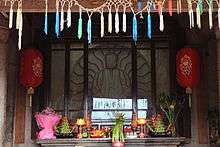
Henning describes how this translation process evolved and influenced the Manichaeans of Central Asia:
Beyond doubt, Sogdian was the national language of the Majority of clerics and propagandists of the Manichaean faith in Central Asia. Middle Persian (Pārsīg), and to a lesser degree, Parthian (Pahlavānīg), occupied the position held by Latin in the medieval church. The founder of Manichaeism had employed Syriac (his own language) as his medium, but conveniently he had written at least one book in Middle Persian, and it is likely that he himself had arranged for the translation of some or all of his numerous writings from Syriac into Middle Persian. Thus the Eastern Manichaeans found themselves entitled to dispense with the study of Mani’s original writings, and to continue themselves to reading the Middle Persian edition; it presented small difficulty to them to acquire a good knowledge of the Middle Persian language, owing to its affinity with Sogdian.[93]
Originally written in Syriac
- the Gospel of Mani (Syriac: ܐܘܢܓܠܝܘܢ /ʔɛwwanɡallijon/; Koinē Greek: εὐαγγέλιον "good news, gospel"). Quotations from the first chapter were brought in Arabic by ibn al-Nadim, who lived in Baghdad at a time when there were still Manichaeans living there, in his 938 book, the Fihrist, a catalog of all written books known to him.
- The Treasure of Life
- The Treatise (Coptic: πραγματεία)
- Secrets
- The Book of Giants: Original fragments were discovered at Qumran (pre-Manichaean) and Turpan.
- Epistles: Augustine brings quotations, in Latin, from Mani's Fundamental Epistle in some of his anti-Manichaean works.
- Psalms and prayers. A Coptic Manichaean Psalter, discovered in Egypt in the early 1900s, was edited and published by Charles Allberry from Manichaean manuscripts in the Chester Beatty collection and in the Berlin Academy, 1938–9.
Originally written in Middle Persian
Other books
- The Ardahang, the "Picture Book". In Iranian tradition, this was one of Mani's holy books that became remembered in later Persian history, and was also called Aržang, a Parthian word meaning "Worthy", and was beautified with paintings. Therefore, Iranians gave him the title of "The Painter".
- The Kephalaia of the Teacher (Κεφαλαια), "Discourses", found in Coptic translation.
- On the Origin of His Body, the title of the Cologne Mani-Codex, a Greek translation of an Aramaic book that describes the early life of Mani.[17]
Non-Manichaean works preserved by the Manichaean Church
- Portions of the Book of Enoch literature such as the Book of Giants
- Literature relating to the apostle Thomas (who by tradition went to India, and was also venerated in Syria), such as portions of the Syriac The Acts of Thomas, and the Psalms of Thomas. The Gospel of Thomas was also attributed to Manichaeans by Cyril of Jerusalem, a fourth-century Church Father.[94]
- The legend of Barlaam and Josaphat passed from an Indian story about the Buddha, through a Manichaean version, before it transformed into the story of a Christian Saint in the west.
Later works

In later centuries, as Manichaeism passed through eastern Persian-speaking lands and arrived at the Uyghur Khaganate (回鶻帝國), and eventually the Uyghur kingdom of Turpan (destroyed around 1335), Middle Persian and Parthian prayers (āfrīwan or āfurišn) and the Parthian hymn-cycles (the Huwīdagmān and Angad Rōšnan created by Mar Ammo) were added to the Manichaean writings.[95] A translation of a collection of these produced the Manichaean Chinese Hymnscroll (Chinese: 摩尼教下部讚; pinyin: Móní-jiào Xiàbù Zàn, which Lieu translates as "Hymns for the Lower Section [i.e. the Hearers] of the Manichaean Religion"[96]). In addition to containing hymns attributed to Mani, it contains prayers attributed to Mani's earliest disciples, including Mār Zaku, Mār Ammo and Mār Sīsin. Another Chinese work is a complete translation of the Sermon of the Light Nous, presented as a discussion between Mani and his disciple Adda.[97]
Critical and polemic sources
Until discoveries in the 1900s of original sources, the only sources for Manichaeism were descriptions and quotations from non-Manichaean authors, either Christian, Muslim, Buddhist, or Zoroastrian. While often criticizing Manichaeism, they also quoted directly from Manichaean scriptures. This enabled Isaac de Beausobre, writing in the 18th century, to create a comprehensive work on Manichaeism, relying solely on anti-Manichaean sources.[98][99] Thus quotations and descriptions in Greek and Arabic have long been known to scholars, as have the long quotations in Latin by Saint Augustine, and the extremely important quotation in Syriac by Theodore Bar Konai.
Patristic depictions of Mani and Manichæeism
Eusebius commented as follows:
The error of the Manichees, which commenced at this time.
— In the mean time, also, that madman Manes, (Mani is of Persian or Semitic origin) as he was called, well agreeing with his name, for his demoniacal heresy, armed himself by the perversion of his reason, and at the instruction of Satan, to the destruction of many. He was a barbarian in his life, both in speech and conduct, but in his nature as one possessed and insane. Accordingly, he attempted to form himself into a Christ, and then also proclaimed himself to be the very paraclete and the Holy Spirit, and with all this was greatly puffed up with his madness. Then, as if he were Christ, he selected twelve disciples, the partners of his new religion, and after patching together false and ungodly doctrines, collected from a thousand heresies long since extinct, he swept them off like a deadly poison, from Persia, upon this part of the world. Hence the impious name of the Manichaeans spreading among many, even to the present day. Such then was the occasion of this knowledge, as it was falsely called, that sprouted up in these times.[100]
Acta Archelai
An example of how inaccurate some of these accounts could be is seen in the account of the origins of Manichaeism contained in the Acta Archelai. This was a Greek anti-manichaean work written before 348, most well known in its Latin version, which was regarded as an accurate account of Manichaeism until refuted by Isaac de Beausobre in the 18th century:
In the time of the Apostles there lived a man named Scythianus, who is described as coming "from Scythia", and also as being "a Saracen by race" ("ex genere Saracenorum"). He settled in Egypt, where he became acquainted with "the wisdom of the Egyptians", and invented the religious system that was afterwards known as Manichaeism. Finally he emigrated to Palestine, and, when he died, his writings passed into the hands of his sole disciple, a certain Terebinthus. The latter betook himself to Babylonia, assumed the name of Budda, and endeavoured to propagate his master's teaching. But he, like Scythianus, gained only one disciple, who was an old woman. After a while he died, in consequence of a fall from the roof of a house, and the books that he had inherited from Scythianus became the property of the old woman, who, on her death, bequeathed them to a young man named Corbicius, who had been her slave. Corbicius thereupon changed his name to Manes, studied the writings of Scythianus, and began to teach the doctrines that they contained, with many additions of his own. He gained three disciples, named Thomas, Addas, and Hermas. About this time the son of the Persian king fell ill, and Manes undertook to cure him; the prince, however, died, whereupon Manes was thrown into prison. He succeeded in escaping, but eventually fell into the hands of the king, by whose order he was flayed, and his corpse was hung up at the city gate.
A. A. Bevan, who quoted this story, commented that it "has no claim to be considered historical".[101]
View of Judaism in the Acta Archelai
According to Hegemonius' portrayal of Mani, the evil demiurge who created the world was the Jewish Jehovah. Hegemonius reports that Mani said,
"It is the Prince of Darkness who spoke with Moses, the Jews and their priests. Thus the Christians, the Jews, and the Pagans are involved in the same error when they worship this God. For he leads them astray in the lusts he taught them." He goes on to state: "Now, he who spoke with Moses, the Jews, and the priests he says is the archont of Darkness, and the Christians, Jews, and pagans (ethnic) are one and the same, as they revere the same god. For in his aspirations he seduces them, as he is not the god of truth. And so therefore all those who put their hope in the god who spoke with Moses and the prophets have (this in store for themselves, namely) to be bound with him, because they did not put their hope in the god of truth. For that one spoke with them (only) according to their own aspirations.[102]
Central Asian and Iranian primary sources
In the early 1900s, original Manichaean writings started to come to light when German scholars led by Albert Grünwedel, and then by Albert von Le Coq, began excavating at Gaochang, the ancient site of the Manichaean Uyghur Kingdom near Turpan, in Chinese Turkestan (destroyed around AD 1300). While most of the writings they uncovered were in very poor condition, there were still hundreds of pages of Manichaean scriptures, written in three Iranian languages (Middle Persian, Parthian, and Sogdian) and old Uyghur. These writings were taken back to Germany, and were analyzed and published at the Prussian Academy of Sciences in Berlin, by Le Coq and others, such as Friedrich W. K. Müller and Walter Bruno Henning. While the vast majority of these writings were written in a version of the Syriac script known as Manichaean script, the German researchers, perhaps for lack of suitable fonts, published most of them using the Hebrew alphabet (which could easily be substituted for the 22 Syriac letters).
Perhaps the most comprehensive of these publications was Manichaeische Dogmatik aus chinesischen und iranischen Texten (Manichaean Dogma from Chinese and Iranian texts), by Ernst Waldschmidt and Wolfgang Lentz, published in Berlin in 1933.[103] More than any other research work published before or since, this work printed, and then discussed, the original key Manichaean texts in the original scripts, and consists chiefly of sections from Chinese texts, and Middle Persian and Parthian texts transcribed with the Hebrew alphabet. After the Nazi Party gained power in Germany, the Manichaean writings continued to be published during the 1930s, but the publishers no longer used Hebrew letters, instead transliterating the texts into Latin letters.
Coptic primary sources
Additionally, in 1930, German researchers in Egypt found a large body of Manichaean works in Coptic. Though these were also damaged, hundreds of complete pages survived and, beginning in 1933, were analyzed and published in Berlin before World War II, by German scholars such as Hans Jakob Polotsky.[104] Some of these Coptic Manichaean writings were lost during the war.
Chinese primary sources
After the success of the German researchers, French scholars visited China and discovered what is perhaps the most complete set of Manichaean writings, written in Chinese. These three Chinese writings, all found at the Mogao Caves among the Dunhuang manuscripts, and all written before the 9th century, are today kept in London, Paris, and Beijing. Some of the scholars involved with their initial discovery and publication were Édouard Chavannes, Paul Pelliot, and Aurel Stein. The original studies and analyses of these writings, along with their translations, first appeared in French, English, and German, before and after World War II. The complete Chinese texts themselves were first published in Tokyo, Japan in 1927, in the Taishō Tripiṭaka, volume 54. While in the last thirty years or so they have been republished in both Germany (with a complete translation into German, alongside the 1927 Japanese edition),[105] and China, the Japanese publication remains the standard reference for the Chinese texts.
Greek life of Mani, Cologne codex
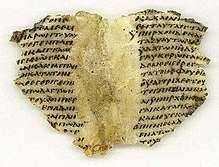
In Egypt, a small codex was found and became known through antique dealers in Cairo. It was purchased by the University of Cologne in 1969. Two of its scientists, Henrichs and Koenen, produced the first edition known since as the Cologne Mani-Codex, which was published in four articles in the Zeitschrift für Papyrologie und Epigraphik. The ancient papyrus manuscript contained a Greek text describing the life of Mani. Thanks to this discovery, much more is known about the man who founded one of the most influential world religions of the past.[106]
Figurative use
The terms "Manichaean" and "Manichaeism" are sometimes used figuratively as a synonym of the more general term "dualist" with respect to a philosophy, outlook or worldview.[107] The terms are often used to suggest that the world view in question simplistically reduces the world to a struggle between good and evil. For example, Zbigniew Brzezinski used the phrase "Manichaean paranoia" in reference to U.S. President George W. Bush's world view (in The Daily Show with Jon Stewart, 14 March 2007); Brzezinski elaborated that he meant "the notion that he [Bush] is leading the forces of good against the empire of evil". Author and journalist Glenn Greenwald followed up on the theme in describing Bush in his book A Tragic Legacy (2007).[108]
The term is frequently used by critics to describe the attitudes and foreign policies of the United States and its leaders.[109][110][111][112][113]
Philosopher Frantz Fanon frequently invoked the concept of Manicheanism in his discussions of violence between colonizers and the colonized.[114]
In "My Secret History", author Paul Theroux's protagonist defines the word Manichaean for the protagonist's son as 'seeing that good and evil are mingled'. Prior to explaining the word to his son, the protagonist mentions Joseph Conrad's short story "The Secret Sharer" at least twice in the book, the plot of which also examines the idea of the duality of good and evil.[115]
See also
- Abū Hilāl al-Dayhūri (8th century)
- Agapius (Manichaean) (4th or 5th centuries)
- Akouas
- Ancient Mesopotamian religion
- Chinese Manichaeism
- Hiwi al-Balkhi
- Indo-Iranian religion
- Mar Ammo (third century)
- Mazdak
- Ming Cult
- Abu Isa al-Warraq
- Yazdânism
- Yazidi
References
- "manichaeism". Oxford English Dictionary (3rd ed.). Oxford University Press. September 2005. (Subscription or UK public library membership required.)
- R. van den Broek, Wouter J. Hanegraaff Gnosis and Hermeticism from Antiquity to Modern TimesSUNY Press, 1998 ISBN 9780791436110 p. 37
- "Mani (Iranian prophet)". Encyclopædia Britannica. Retrieved 4 October 2013.
- "Manichaeism". Encyclopædia Britannica. Archived from the original on 3 June 2013. Retrieved 4 September 2013.
- "Manichaeism". New Advent Encyclopedia. Retrieved 4 October 2013.
- "Cosmogony and Cosmology iii. In Manicheism". Encyclopædia Iranica. Retrieved 24 February 2018.
[I]n Manicheism the world was a prison for demons...
- Widengren, Geo Mesopotamian elements in Manichaeism (King and Saviour II): Studies in Manichaean, Mandaean, and Syrian-gnostic religion, Lundequistska bokhandeln, 1946.
- Jason BeDuhn; Paul Allan Mirecki (2007). Frontiers of Faith: The Christian Encounter With Manichaeism in the Acts of Archelaus. BRILL. p. 6. ISBN 978-90-04-16180-1.
- Andrew Welburn, Mani, the Angel and the Column of Glory: An Anthology of Manichaean Texts (Edinburgh: Floris Books, 1998), p. 68
- Jason David BeDuhn The Manichaean Body: In Discipline and Ritual Baltimore: Johns Hopkins University Press. 2000 republished 2002 p.IX
- Such as the Nicene and Post-Nicene Fathers First Series, ed. Philip Schaff, writing of Augustine
- Merriam-Webster ─ Manichaean
- Mary Boyce, Zoroastrians: their religious beliefs and practices, Routledge, 2001. p. 111: "He was Iranian, of noble Parthian blood ..."
- Warwick Ball, Rome in the East: the transformation of an empire, Routledge, 2001. p. 437: "Manichaeism was a syncretic religion, proclaimed by the Iranian Prophet Mani ...
-
According to the Fehrest, Mani was of Arsacid stock on both his father's and his mother's sides, at least if the readings al-ḥaskāniya (Mani's father) and al-asʿāniya (Mani's mother) are corrected to al-aškāniya and al-ašḡāniya (ed. Flügel, 1862, p. 49, ll. 2 and 3) respectively. The forefathers of Mani's father are said to have been from Hamadan and so perhaps of Iranian origin (ed. Flügel, 1862, p. 49, 5–6). The Chinese Compendium, which makes the father a local king, maintains that his mother was from the house Jinsajian, explained by Henning as the Armenian Arsacid family of Kamsarakan (Henning, 1943, p. 52, n. 4 1977, II, p. 115). Is that fact, or fiction, or both? The historicity of this tradition is assumed by most, but the possibility that Mani's noble Arsacid background is legendary cannot be ruled out (cf. Scheftelowitz, 1933, pp. 403–4). In any case, it is characteristic that Mani took pride in his origin from time-honored Babel, but never claimed affiliation to the Iranian upper class.
- John Kevin Coyle (15 September 2009). Manichaeism and Its Legacy. BRILL. pp. 13–. ISBN 978-90-04-17574-7. Retrieved 27 August 2012.
- L. Koenen and C. Römer, eds., Der Kölner Mani-Kodex. Über das Werden seines Leibes. Kritische Edition, (Abhandlung der Reinisch-Westfälischen Akademie der Wissenschaften: Papyrologica Coloniensia 14) (Opladen, Germany) 1988.
- Manichaeism at Encyclopædia Iranica
- Middle Persian Sources: D. N. MacKenzie, Mani's Šābuhragān, pt. 1 (text and translation), BSOAS 42/3, 1979, pp. 500–34, pt. 2 (glossary and plates), BSOAS 43/2, 1980, pp. 288–310.
- Welburn (1998), pp. 67–68
- John C. Reeves (1996). Heralds of That Good Realm: Syro-Mesopotamian Gnosis and Jewish Traditions. BRILL. pp. 6–. ISBN 978-90-04-10459-4. Retrieved 27 August 2012.
- Lutkemeyer, Lawrence J. (1946). "The Role of the Paraclete (Jn. 16:7–15)". The Catholic Biblical Quarterly. 8 (2): 220–229. JSTOR 43719890.
- Lieu, Samuel N. C. (1 January 1992). Manichaeism in the Later Roman Empire and Medieval China. ISBN 9783161458200.
- Saint Augustine, Bishop of Hippo (2006). The Manichean Debate. ISBN 9781565482470. Retrieved 18 August 2012.
- "The movement of the Manichaean tradition along the Silk Road". Silkspice.wordpress.com. 5 April 2011. Retrieved 18 August 2012.
- Eschatology ii. Manichean Eschatology at Encyclopædia Iranica
- C. Colpe, "Das Siegel der Propheten: historische Beziehungen zwischen Judentum, Judenchristentum, Heidentum und frühem Islam", Arbeiten zur neutestamentlichen Theologie und Zeitgeschichte, 3 (Berlin: Institut Kirche und Judentum, 1990), 227–243.
- G. G. Stroumsa, The Making of the Abrahamic Religions in Late Antiquity, Oxford Studies in the Abrahamic Religions (Oxford: Oxford University Press, 2015), 68.
- "The Dead Sea Scrolls - 1Q Enoch, Book of Giants". The Dead Sea Scrolls - 1Q Enoch, Book of Giants. Retrieved 7 October 2019.
- J. T. Milik, ed. and trans., The Books of Enoch: Aramaic Fragments of Qumran Cave 4, Oxford: Clarendon Press, 1976.
- In: Henning, W. B., The Book of Giants, BSOAS, Vol. XI, Part 1, 1943, pp. 52–74.
- Reeves, John C. Jewish Lore in Manichaean Cosmogony: Studies in the Book of Giants Traditions (1992)
- See Henning, A Sogdian Fragment of the Manichaean Cosmogony, BSOAS, 1948
- Original Syriac in: Theodorus bar Konai, Liber Scholiorum, II, ed. A. Scher, Corpus Scriptorum Christianorum Orientalium scrip. syri, 1912, pp. 311–8, ISBN 978-90-429-0104-9; English translation in: A.V.W. Jackson, Researches in Manichaeism, New York, 1932, pp. 222–54.
- Richard Foltz, Religions of the Silk Road, Palgrave Macmillan, 2nd edition, 2010, p. 71 ISBN 978-0-230-62125-1
- Peter Bryder, The Chinese Transformation of Manichaeism: A Study of Chinese Manichaean Terminology, 1985.
- Lieu, Samuel (1992) Manichaeism in the Later Roman Empire and Medieval China 2d edition, pp. 145–148
- Wendy Doniger (1999). Merriam-Webster's Encyclopedia of World Religions. Merriam-Webster. pp. 689, 690. ISBN 9789068310023.
- "St. Augustine of Hippo". Catholic.org. Retrieved 18 August 2012.
- Confessions, Book V, Section 10.
- A. Adam, Das Fortwirken des Manichäismus bei Augustin. In: ZKG (69) 1958, S. 1–25.
- Runciman, Steven, The Medieval Manichee: a study of the Christian dualist heresy. Cambridge University Press, 1947.
- Étienne de la Vaissière, "Mani en Chine au VIe siècle", Journal asiatique, 293–1 (2005): 357–378.
- 从信仰摩尼教看漠北回纥
- 关于回鹘摩尼教史的几个问题 Archived 7 August 2007 at the Wayback Machine
- "九姓回鹘爱登里罗汨没蜜施合毗伽可汗圣文神武碑". Bbs.sjtu.edu.cn. Archived from the original on 24 December 2013. Retrieved 14 February 2014.
- TM276 Uygurca_Alttuerkisch_Qedimi Uygurche/TT 2.pdf Türkische Turfan-Texte. ~
- Perkins, Dorothy (2013). Encyclopedia of China: History and Culture. Routledge. p. 309. ISBN 9781135935627.
- S. N. C. L. Lieu (1998). Manachaeism in Central Asia and China. Brill Publishers. pp. 115, 129, 130. ISBN 9789004104051.
- Patricia Ebrey, Anne Walthall (2013). Pre-Modern East Asia: A Cultural, Social, and Political History, Volume I: To 1800. Cengage. p. 228. ISBN 9781285546230.
- Chung, Tan (1998). Across the Himalayan Gap: An Indian Quest for Understanding China. Gyan Publishing House. p. 232. ISBN 9788121206174.
- Xisha Ma, Huiying Meng (2011). Popular Religion and Shamanism. Brill Publishers. pp. 56, 57, 99. ISBN 9789004174559.
- Schaeffer, Kurtis; Kapstein, Matthew; Tuttle, Gray (2013). Sources of Tibetan Tradition. New York: Columbia University Press. pp. 95, 96. ISBN 9780231135993.
- Andrew Rippin (2013). The Islamic World. Routledge. p. 73. ISBN 9781136803437.
- Jonathan Porter Berkey (2003). The Formation of Islam: Religion and Society in the Near East. Cambridge University Press. pp. 99, 100. ISBN 9780521588133.
- Bernard Lewis (2009). The Middle East. Simon & Schuster. ISBN 9781439190005.
- Ann K. S. Lambton (2013). State and Government in Medieval Islam. Routledge. pp. 50, 51. ISBN 9781136605215.
- Zaman, Muhammad Qasim (1997), Religion and Politics Under the Early 'Abbasids: The Emergence of the Proto-Sunni Elite, Brill, pp. 63–65, ISBN 978-9004106789
- Ibrahim, Mahmood (1994). "Religious inquisition as social policy: the persecution of the 'Zanadiqa' in the early Abbasid Caliphate". Arab Studies Quarterly. Archived from the original on 11 July 2012.
- Christine Caldwell Ames (2015). Medieval Heresies. Cambridge University Press. p. 88. ISBN 9781107023369.
- Irfan Shahîd, Byzantium and the Arabs in the fourth century, 1984, p. 425.
- Jacques Duchesne-Guillemin, Pierre Lecoq (1985). Papers in Honor of Professor Mary Boyce. Brill Publishers. p. 658. ISBN 9789068310023.
- J. Gordon Melton (2014). Faiths Across Time: 5000 years of Religious History. ABC-CLIO. p. 361. ISBN 9781610690263.
- Liu, Xinru (1997). Silk and Religion: An Exploration of Material Life and the Thought of People, AD 600-1200, Parts 600–1200. Oxford University Press. p. 182. ISBN 9780195644524.
- Samuel N. C. Lieu (1985). Manichaeism in the Later Roman Empire and Medieval China: A Historical Survey. Manchester University Press. p. 261. ISBN 9780719010880.
- ter Haar, B. J. (1999). The White Lotus Teachings in Chinese Religious History. University of Hawaii Press. ISBN 9780824822187.
- Wendy Doniger (1999). Merriam-Webster's Encyclopedia of World Religions. Merriam-Webster. p. 690. ISBN 9789068310023.
- Stroumsa, Gedaliahu G., "Anti-Cathar Polemics and the Liber de duobus principiis", in B. Lewis and F. Niewöhner, eds., Religionsgespräche im Mittelalter (Wolfenbütteler Mittelalter-Studien, 4; Wiesbaden: Harrassowitz, 1992), 169–183, p. 170
- "Catholic Encyclopedia: Paulicians". Newadvent.org. 1 February 1911. Retrieved 18 August 2012.
- Dondaine, Antoine. O. P. Un traite neo-manicheen du XIIIe siecle: Le Liber de duobus principiis, suivi d'un fragment de rituel Cathare (Rome: Institutum Historicum Fratrum Praedicatorum, 1939)
- "Catholic Encyclopedia: Albigenses". Newadvent.org. 1 March 1907. Retrieved 18 August 2012.
- 明教在温州的最后遗存 – 温州社会研究所. 25 August 2013. Archived from the original on 25 August 2013.
- 崇寿宫记. Cxsz.cixi.gov.cn. 8 October 2012. Archived from the original on 13 May 2013. Retrieved 14 February 2014.
- "Manichaean and (Nestorian) Christian Remains in Zayton (Quanzhou, South China) ARC DP0557098". Mq.edu.au. Archived from the original on 8 August 2014. Retrieved 27 August 2014.
- "Central Manichaean Temple". Manichaean.org. 20 June 2014. Archived from the original on 24 July 2013. Retrieved 27 August 2014.
- 天书降世 弥勒古佛说风轮真经全卷_龙华会聚原人_新浪博客. Blog.sina.com.cn. 14 June 2011. Retrieved 14 February 2014.
- "Neo-Manichaeanism: Questions and Answers". Oocities.org. Retrieved 27 August 2014.
- Bevan, A. A. (1930). "Manichaeism". Encyclopaedia of Religion and Ethics, Volume VIII Ed. James Hastings. London
- A completely sourced description (built around bar-Khoni's account, with additional sources), is found in: Jonas, Hans The Gnostic Religion, 1958, Ch. 9: Creation, World History, Salvation According to Mani.
- Chart from: E. Waldschmidt and W. Lenz, Die Stellung Jesu im Manichäismus, Berlin, 1926, p 42.
- These are apparently the 'twelve centuries clothed with flowers and full of melodies' (duodecim saecula floribus convestita et canoribus plena) at St Augustine, Contra Faustum, 15.5.
- "AUGUSTINE AND MANICHAEISM". www-personal.umich.edu. Retrieved 5 April 2020.
- G. Haloun and W. B. Henning, The Compendium of the Doctrines and Styles of the Teaching of Mani, the Buddha of Light, Asia Major, 1952, pp. 184–212, p. 195.
- "Manichæism". The Catholic Encyclopedia. 1910.
- J. van (Johannes) Oort, Jacob Albert van den Berg In Search of Truth. Augustine, Manichaeism and Other Gnosticism: Studies for Johannes Van Oort at Sixty BRILL, 2011 ISBN 9789004189973 p. 258
- Jason BeDuhn New Light on Manichaeism: Papers from the Sixth International Congress on Manichaeism, Organized by the International Association of Manichaean Studies BRILL, 2009 ISBN 9789004172852 p. 77
- Johannes van Oort Augustine and Manichaean Christianity: Selected Papers from the First South African Conference on Augustine of Hippo, University of Pretoria, 24–26 April 2012 BRILL, 01.08.2013 ISBN 9789004255067 p. 74
- Charles George Herbermann The Catholic Encyclopedia: An International Work of Reference on the Constitution, Doctrine, Discipline, and History of the Catholic Church, Band 9 Universal Knowledge Foundation, 1913 Digit. 16. Aug. 2006 p. 594
- New Light on Manichaeism: Papers from the Sixth International Congress o p. 78
- Johannes van Oort Augustine and Manichaean Christianity: Selected Papers from the First South African Conference on Augustine of Hippo, University of Pretoria, 24–26 April 2012 BRILL, 01.08.2013 ISBN 9789004255067 p. 75
- Manicheism i. General Survey at Encyclopædia Iranica
- Chinese Turkestan: vii. Manicheism in Chinese Turkestan and China at Encyclopædia Iranica
- W. B. Henning, Sogdica, 1940, p. 11.
- "Let none read the gospel according to Thomas, for it is the work, not of one of the twelve apostles, but of one of Mani's three wicked disciples."—Cyril of Jerusalem, Cathechesis V (4th century)
- See, for example, Boyce, Mary The Manichaean hymn-cycles in Parthian (London Oriental Series, Vol. 3). London: Oxford University Press, 1954.
- Lieu, Samuel N. C., Manichaeism in Central Asia and China, 1998, p. 50.
- "The Traité is, despite its title (Moni jiao cao jing, lit. "fragmentary [Mathews, no. 6689] Manichean scripture"), a long text in an excellent state of preservation, with only a few lines missing at the beginning. It was first fully published with a facsimile by Edouard Chavannes (q.v.) and Paul Pelliot in 1911 and is frequently known as Traité Pelliot. Their transcription (including typographical errors) was reproduced in the Chinese translation of the Buddhist Tripiṭaka (Taishō, no. 2141 B, LIV, pp. 1281a16-1286a29); that text was in turn reproduced with critical notes by Helwig Schmidt-Glintzer (1987b, pp. T. 81–86). A more accurate transcription was published by Chen Yuan in 1923 (pp. 531–44), and a new collation based on a reexamination of the original photographs of the manuscript has now been published by Lin Wu-shu (1987, pp. 217–29), with the photographs", Chinnese Turkestan vii. Manicheism in Chinese Turkestan and China at Encyclopædia Iranica
- de Beausobre, Isaac (1734). Histoire critique de Manichée et du manichéisme [Critical history of Manichae and Manichaeism] (in French). 1. Amsterdam: J. Frederic Bernard.
- Beausobre, Isaac de; Formey, S. (1739). Histoire critique de Manichée et du manichéisme [Critical history of Manichae and Manichaeism] (in French). 2. Amsterdam: J. Frederic Bernard.
- Eusebius. The Ecclesiastical History of Eusebius Pamphilus, Bishop of Caesarea, Translated from the originals by Christian Frederick Cruse.1939. Ch. XXXI.
- Bevan, A. A. (1930). "Manichaeism". Encyclopaedia of Religion and Ethics, Volume VIII. Ed. James Hastings. London.
- "Classical Texts: Acta Archelai of Mani" (PDF). Iranian Studies at Harvard University. p. 76.
- Waldschmidt, E., and Lentz, W., Manichäische Dogmatik aus chinesischen und iranischen Texten (SPAW 1933, No. 13)
- Hans Jakob Polotsky and Karl Schmidt, Ein Mani-Fund in Ägypten, Original-Schriften des Mani und seiner Schüler. Berlin: Akademie der Wissenschaften 1933.
- Schmidt-Glintzer, Helwig, Chinesische Manichaeica, Wiesbaden, 1987
- "Cologne Mani Codex". Encyclopedia Iranica.
- "Manichaean - definition of Manichaean in English from the Oxford dictionary".
- "Wednesday's Book Review: "A Tragic Legacy: How a Good vs. Evil Mentality Destroyed the Bush Presidency"". Roger Launius's Blog. 28 June 2017. Retrieved 12 November 2018.
- "The Revenge Of The Lost Boys". 9 July 2015.
- "Ode to a philistine: Howard Jacobson's Pussy". www.newstatesman.com.
- Kaplan, Fred (21 October 2004). "Paul Nitze" – via Slate.
- "Why America Misunderstands the World: National Experience and Roots of Misperception". 29 November 2016.
- Bryant, Nick (10 July 2015). "The decline of US power?". BBC News – via www.bbc.com.
- "Frantz Fanon". Archived from the original on 15 August 2016.
- Theroux, Paul (1989). My Secret History. New York: G. P. Putnam's Sons. pp. 471, 473. ISBN 0-399-13424-7.
Books and articles
- Ibscher, Hugo (1938). Allberry Charles R. C. (ed.). Manichaean Manuscripts in the Chester Beatty Collection: Vol II, part II: A Manichaean Psalm Book. Stuttgart: W. Kohlammer.
- Beatty, Alfred Chester (1938). Charles Allberry (ed.). A Manichean Psalm-Book, Part II. Stuttgart.
- Beausobre, de, Isaac (1734–1739). Histoire critique de Manichée et du Manichéisme. Amsterdam: Garland Pub. ISBN 978-0-8240-3552-5.
- BeDuhn, Jason David (2002). The Manichaean Body: In Discipline and Ritual. Baltimore: Johns Hopkins University Press. ISBN 978-0-8018-7107-8.
- Cross, F. L.; E. A. Livingstone (1974). The Oxford Dictionary of the Christian Church. London: Oxford UP: Oxford University Press. ISBN 978-0-19-211545-4.
- Favre, Francois (5 May 2005). Mani, the Gift of Light. Renova symposium. Bilthoven, The Netherlands.
- Foltz, Richard (2010). Religions of the Silk Road. New York: Palgrave Macmillan. ISBN 978-0-230-62125-1.
- Foltz, Richard (2013). Religions of Iran: From Prehistory to the Present. London: Oneworld publications. ISBN 978-1-78074-308-0.
- Gardner, Iain; Samuel N. C. Lieu (2004). Manichaean Texts from the Roman Empire. Cambridge: Cambridge Univ. Press. ISBN 978-0-521-56822-7.
- Giversen, Soren (1988). The Manichaean Coptic Papyri in The Chester Beatty Library Vol. III: Psalm Book part I. (Facsimile ed.). Geneva: Patrick Crammer. (Cahiers D'Orientalism XVI) 1988a
- Giversen, Soren (1988). The Manichaean Coptic Papyri in The Chester Beatty Library Vol. IV: Psalm Book part II (Facsimile ed.). Geneva: Patrick Crammer. (Cahiers D'Orientalism XVI) 1988b.
- Grousset, Rene (1939), tr. Walford, Naomi (1970), The Empire of the Steppes: A History of Central Asia, New Brunswick, N.J.: Rutgers.ISBN 978-0-8135-1304-1.
- Gulácsi, Zsuzsanna (2001). Manichaean art in Berlin Collections. Turnhout. (Original Manichaean manuscripts found since 1902 in China, Egypt, Turkestan to be seen in the Museum of Indian Art in Berlin.)
- Heinrichs, Albert; Ludwig Koenen, Ein griechischer Mani-Kodex, 1970 (ed.) Der Kölner Mani-Codex ( P. Colon. Inv. nr. 4780), 1975–1982.
- La Vaissière, Etienne de, "Mani en Chine au VIe siècle", Journal Asiatique, 293–1, 2005, p. 357–378.
- Legge, Francis (1964) [1914]. Forerunners and Rivals of Christianity, From 330 B.C. to 330 A.D.. New York: University Books. LC Catalog 64-24125. reprinted in two volumes bound as one
- Lieu, Samuel (1992). Manichaeism in the Later Roman Empire and Medieval China. Tübingen: J. C. B. Mohr. ISBN 978-0-7190-1088-0.
- Mani (216–276/7) and his 'biography': the Codex Manichaicus Coloniensis (CMC):
- Melchert, Norman (2002). The Great Conversation: A Historical Introduction to Philosophy. McGraw Hill. ISBN 978-0-19-517510-3.
- Runciman, Steven (1982) [1947]. The Medieval Manichee: a study of the Christian dualist heresy. Cambridge University Press. ISBN 978-0-521-28926-9.
- Welburn, Andrew (1998). Mani, the Angel and the Column of Glory. Edinburgh: Floris. ISBN 978-0-86315-274-0.
- Widengren, Geo (1965). Mani and Manichaeism. London: Weidenfeld & Nicolson.
- Wurst, Gregor (July 2001). "Die Bema-Psalmen". Journal of Near Eastern Studies. 60 (3): 203–204. doi:10.1086/468925.
External links
| Wikimedia Commons has media related to Manichaeism. |
| Wikisource has the text of the 1911 Encyclopædia Britannica article Manichaeism. |
Outside articles
- Catholic Encyclopedia – Manichæism public domain, published 1917.
- International Association of Manichaean Studies
- Manichaean and Christian Remains in Zayton (Quanzhou, South China)
- Religions of Iran: Manichaeism by I.J.S. Taraporewala
- 专题研究–摩尼教研究
- 《光明皇帝》明尊教背景书(1)
Manichaean sources in English translation
- A summary of the Manichaean creation myth
- Manichaean Writings
- Manicheism. Complete bibliography and selection of Manichaean source texts in PDF format:
- The Book of the Giants by W.B. Henning, 1943
Secondary Manichaean sources in English translation
Manichaean sources in their original languages
- Photos of the Entire Koeln Mani-Kodex (Greek).
- The Syriac Manichaean work quoted by Theodor bar Khonai
- Photos of the Original Middle Persian Manichaean Writings/Fragments Discovered at Turpan (The index of this German site can be searched for additional Manichaean material, including photos of the original Chinese Manichaean writings)
- "Sermon of the Soul", in Parthian and Sogdian
- Middle Persian and Parthian Texts
- D. N. MacKenzie, Mani's Šābuhragān, pt. 1 (text and translation), BSOAS 42/3, 1979, pp. 500–34, pt. 2 (glossary and plates), BSOAS 43/2, 1980, pp. 288–310 .
- Chinese Manichaean Scriptures: 摩尼教殘經一 ("Incomplete Sutra one of Manichaeism") & 摩尼光佛教法儀略("The Mani Bright Buddha teaching plan") & 下部讚("The Lower Part Praises")
